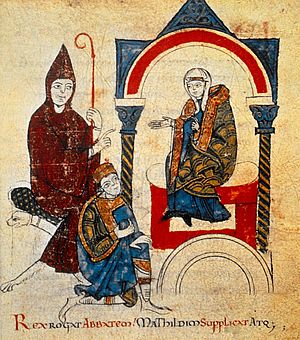Matilda of Tuscany facts for kids
Quick facts for kids Matilda of Canossa |
|
|---|---|

Matilda of Canossa and Hugh of Cluny as advocates of Henry IV
|
|
| Margravine of Tuscany | |
| Reign | 1055–1115 |
| Predecessor | Frederick |
| Successor | Rabodo |
| Regent | Beatrice of Bar 1052–1069 Godfrey III 1053–1069 |
| Co-rule | Godfrey IV 1069–1076 Welf II 1089–1095 |
| Born | c. 1046 Lucca or Mantua |
| Died | 24 July 1115 (aged 68–69) Bondeno di Roncore, Reggiolo, Margraviate of Tuscany |
| Burial | Polirone Abbey (until 1633) Castel Sant'Angelo (until 1645) St. Peter's Basilica (since 1645) |
| Spouse |
|
| House | House of Canossa (Attonids) |
| Father | Boniface III, Margrave of Tuscany |
| Mother | Beatrice of Lorraine |
Matilda of Tuscany (born around 1046, died July 24, 1115) was a very powerful noblewoman in Italy during the 11th century. She was part of the House of Canossa, a famous family. Matilda was one of the most important women in the Middle Ages in Italy.
She ruled a large area as a feudal margravine. This meant she managed lands and people for a king or emperor. Her territory included parts of what are now Lombardy, Emilia, Romagna, and Tuscany. Her main home was Canossa Castle, located in the Apennine mountains.
Matilda was also related to the Holy Roman Emperor and played a key role in a big conflict called the Investiture Controversy. This was a fight between the Pope and the Emperor over who had the right to choose church leaders.
Contents
Matilda's Early Life and Power
Matilda was born around 1046. Her family, the House of Canossa, was very important in Italy. When she grew up, she became a powerful ruler. She controlled a large area of land, making her one of the most influential people in Italy.
Her main castle, Canossa, became the center of her lands. From here, she managed her territories and dealt with important political matters.
The Investiture Controversy and Canossa
The Investiture Controversy was a major disagreement between the Pope and the Holy Roman Emperor. In 1076, Pope Gregory VII removed and excommunicated (kicked out of the church) Emperor Henry IV.
Matilda helped to bring them together. In January 1077, Henry IV made a famous journey to Canossa Castle. He walked in the snow as a sign of regret. The Pope then accepted him back into the church. This event is known as the Road to Canossa.
However, the peace between the Emperor and the Pope did not last long. Matilda strongly supported the Pope in the conflicts that followed. From 1080, she used her army and wealth to help the Papacy. Her court became a safe place for many people affected by the dispute.
Challenges and Triumphs
Between 1081 and 1098, Matilda's rule faced many problems because of her ongoing fights with Henry IV. Not much is known about this difficult period. Things started to change when Matilda formed an alliance with dukes from southern Germany who were against Henry IV.
After Henry IV left Italy in 1097, a power vacuum (a lack of strong leadership) appeared. This struggle between the Emperor and the Pope changed Italian cities forever. It allowed them to gain more freedom and develop their own local governments.
From late 1098, Matilda began to get back many of the lands she had lost. She worked hard to bring the cities under her control again. In her later years, she focused on her legacy. Since she had no children, she gave many gifts to the Polirone Abbey instead of finding an heir.
Matilda's Lasting Legacy
Matilda was sometimes called "the Great Countess" (la Gran Contessa). She lived in a time of constant battles and political tricks. She showed amazing leadership skills, even during very hard times.
In 1111, it is said that Henry V, Holy Roman Emperor crowned Matilda as an Imperial Vicar and Vice-Queen of Italy. This meant she had great power and authority.
Matilda died in 1115, and her family line, the House of Canossa, ended with her. After her death, Popes and Emperors fought over her rich inheritance, known as the "Matildine domains." This continued for many years.
Matilda became a legend in Italy. Many stories, songs, and artworks were created about her. Her fame grew even more during the Counter-Reformation and the Baroque Period. In 1630, Pope Urban VIII had Matilda's body moved to Rome. She was the first woman to be buried in St. Peter's Basilica.
Images for kids
-
Adalbert-Atto of Canossa and his wife Hildegard surrounded by arches, and their sons Rudolph, Geoffrey (Gotofred) and Tedald at their feet. Donizo's Vita Mathildis (Vatican Library, Codex Vat. Lat. 4922, fol. 20v)
-
The states of the Apennine Peninsula in the second half of the 11th century.
-
Anselm of Canterbury hands over his work to Matilda. Miniature in a manuscript by Anselm's Orationes (Diocese of Salzburg, around 1160). Admont, Abbey Library, Ms. 289, fol. 1v.
-
Gospels of Matilda of Tuscany, San Benedetto Po (al Polirone), before 1099. New York, Morgan Library & Museum, MS M.492, fol. 84r.
See also
 In Spanish: Matilde de Canossa para niños
In Spanish: Matilde de Canossa para niños








